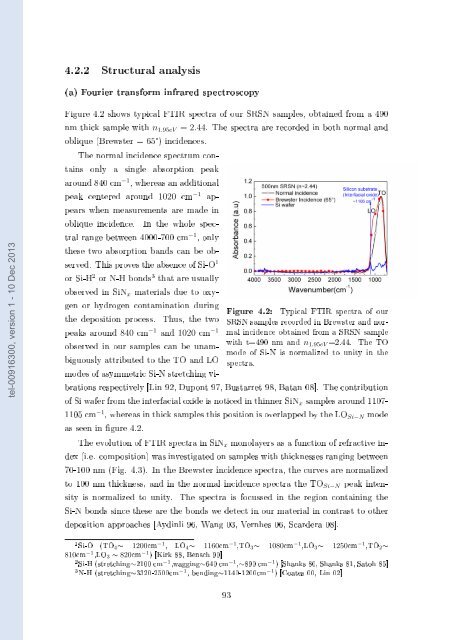Films minces à base de Si nanostructuré pour des cellules ...
Films minces à base de Si nanostructuré pour des cellules ...
Films minces à base de Si nanostructuré pour des cellules ...
Create successful ePaper yourself
Turn your PDF publications into a flip-book with our unique Google optimized e-Paper software.
4.2.2 Structural analysis<br />
(a) Fourier transform infrared spectroscopy<br />
tel-00916300, version 1 - 10 Dec 2013<br />
Figure 4.2 shows typical FTIR spectra of our SRSN samples, obtained from a 490<br />
nm thick sample with n 1.95eV = 2.44. The spectra are recor<strong>de</strong>d in both normal and<br />
oblique (Brewster = 65°) inci<strong>de</strong>nces.<br />
The normal inci<strong>de</strong>nce spectrum contains<br />
only a single absorption peak<br />
around 840 cm −1 , whereas an additional<br />
peak centered around 1020 cm −1 appears<br />
when measurements are ma<strong>de</strong> in<br />
Figure 4.2: Typical FTIR spectra of our<br />
SRSN samples recor<strong>de</strong>d in Brewster and normal<br />
inci<strong>de</strong>nce obtained from a SRSN sample<br />
with t=490 nm and n 1.95eV =2.44. The TO<br />
mo<strong>de</strong> of <strong>Si</strong>-N is normalized to unity in the<br />
spectra.<br />
oblique inci<strong>de</strong>nce. In the whole spectral<br />
range between 4000-700 cm −1 , only<br />
these two absorption bands can be observed.<br />
This proves the absence of <strong>Si</strong>-O 1<br />
or <strong>Si</strong>-H 2 or N-H bonds 3 that are usually<br />
observed in <strong>Si</strong>N x materials due to oxygen<br />
or hydrogen contamination during<br />
the <strong>de</strong>position process. Thus, the two<br />
peaks around 840 cm −1 and 1020 cm −1<br />
observed in our samples can be unambiguously<br />
attributed to the TO and LO<br />
mo<strong>de</strong>s of asymmetric <strong>Si</strong>-N stretching vibrations<br />
respectively [Lin 92, Dupont 97, Bustarret 98, Batan 08]. The contribution<br />
of <strong>Si</strong> wafer from the interfacial oxi<strong>de</strong> is noticed in thinner <strong>Si</strong>N x samples around 1107-<br />
1105 cm −1 , whereas in thick samples this position is overlapped by the LO <strong>Si</strong>−N mo<strong>de</strong><br />
as seen in gure 4.2.<br />
The evolution of FTIR spectra in <strong>Si</strong>N x monolayers as a function of refractive in<strong>de</strong>x<br />
(i.e. composition) was investigated on samples with thicknesses ranging between<br />
70-100 nm (Fig. 4.3). In the Brewster inci<strong>de</strong>nce spectra, the curves are normalized<br />
to 100 nm thickness, and in the normal inci<strong>de</strong>nce spectra the TO <strong>Si</strong>−N peak intensity<br />
is normalized to unity. The spectra is focussed in the region containing the<br />
<strong>Si</strong>-N bonds since these are the bonds we <strong>de</strong>tect in our material in contrast to other<br />
<strong>de</strong>position approaches [Aydinli 96, Wang 03, Vernhes 06, Scar<strong>de</strong>ra 08].<br />
1 <strong>Si</strong>-O (TO 4 ∼ 1200cm −1 , LO 4 ∼ 1160cm −1 ,TO 3 ∼ 1080cm −1 ,LO 3 ∼ 1250cm −1 ,TO 2 ∼<br />
810cm −1 ,LO 3 ∼ 820cm −1 ) [Kirk 88, Bensch 90]<br />
2 <strong>Si</strong>-H (stretching∼2100 cm −1 ,wagging∼640 cm −1 ,∼890 cm −1 ) [Shanks 80, Shanks 81, Satoh 85]<br />
3 N-H (stretching∼3320-2500cm −1 , bending∼1140-1200cm −1 ) [Coates 00, Lin 02]<br />
93
















